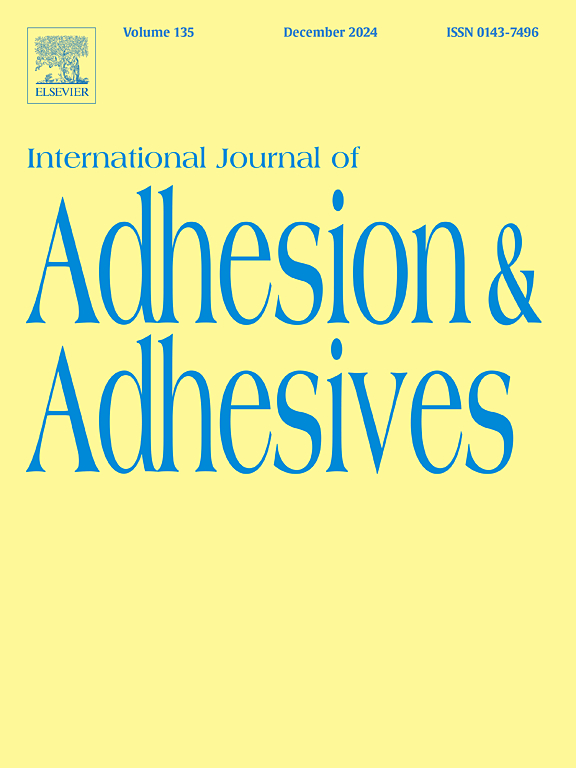表面处理对CAD-CAM树脂复合材料疲劳和静态弯曲结合强度的影响
IF 3.5
3区 材料科学
Q2 ENGINEERING, CHEMICAL
International Journal of Adhesion and Adhesives
Pub Date : 2025-02-27
DOI:10.1016/j.ijadhadh.2025.103994
引用次数: 0
摘要
本体外研究的目的是评估修复CAD-CAM树脂复合材料前不同表面处理对直接树脂复合材料的疲劳和静态弯曲结合强度的影响。为此,将CAD- cam树脂复合块(Tetric CAD)进行研磨,分为3组:50 μm粒度的氧化铝气磨剂+粘合剂(AA + AD组)、仅粘合剂(AD组)和硅烷(SIL组)。直接树脂复合材料(DIR-RC)和间接树脂复合材料(IND-RC)的内聚强度也进行了测试。将砌块切成1 × 2 × 12 mm的梁,进行静载下抗弯强度(内聚强度)和抗弯粘结强度(修复样)试验(n= 10;1 mm/min)和循环疲劳(n= 15;初始负载= 5 N, 1.4 Hz,步长= 5 N,每步循环10,000次),使用球内孔装置。结果在MPa下进行了有限元分析。并进行了失效分析和地形分析。AA + AD组和AD组的静态弯曲结合强度高于SIL组,但疲劳后无差异。IND-RC组在静态和疲劳条件下均表现出最高的抗弯强度。疲劳后,所有组的粘结强度均下降,其中SIL表现出最明显的退化。表面处理均不能恢复CAD-CAM材料的原始强度。表面磨削,无论随后是否空气磨损,结合粘合剂的应用,产生类似的结果。因此,粘接与表面磨削相结合是CAD-CAM树脂复合材料修复的有效途径。本文章由计算机程序翻译,如有差异,请以英文原文为准。
Effectiveness of surface treatments on fatigue and static flexural bond strength of a CAD-CAM resin composite
The aim of this in vitro study was to evaluate the effect of different surface treatments before repairing a CAD-CAM resin composite on fatigue and static flexural bond strength with a direct resin composite. For this, CAD-CAM resin composite blocks (Tetric CAD) were ground and divided into 3 groups: aluminum oxide air-abrasion (50-μm grain-size) + adhesive (AA + AD group), adhesive only (AD group), and silane (SIL group). Direct (DIR-RC) and indirect resin composite (IND-RC) were also tested for cohesive strength. Blocks were sectioned into beams (1 × 2 × 12 mm) and submitted to flexural strength (cohesive strength) and flexural bond strength (repaired sample) tests under static load (n= 10; 1 mm/min) and cyclic fatigue (n= 15; initial load= 5 N, 1.4 Hz, step-size= 5 N, 10,000 cycles per step) using a ball-in-hole device. Results were analyzed in MPa via finite element analysis. Failure analysis and topographic analysis were also conducted. The AA + AD and AD groups showed higher static flexural bond strength than SIL, but no differences were observed after fatigue. The IND-RC group exhibited the highest flexural strength under both static and fatigue conditions. All groups showed reduced bond strength after fatigue, with SIL presenting the most pronounced degradation. None of the surface treatments restored the original strength of CAD-CAM material. Surface grinding, whether followed by air abrasion or not, combined with adhesive application, yielded comparable outcomes. Therefore, the combination of adhesive application with surface grinding is an effective approach for CAD-CAM resin composite repair.
求助全文
通过发布文献求助,成功后即可免费获取论文全文。
去求助
来源期刊

International Journal of Adhesion and Adhesives
工程技术-材料科学:综合
CiteScore
6.90
自引率
8.80%
发文量
200
审稿时长
8.3 months
期刊介绍:
The International Journal of Adhesion and Adhesives draws together the many aspects of the science and technology of adhesive materials, from fundamental research and development work to industrial applications. Subject areas covered include: interfacial interactions, surface chemistry, methods of testing, accumulation of test data on physical and mechanical properties, environmental effects, new adhesive materials, sealants, design of bonded joints, and manufacturing technology.
 求助内容:
求助内容: 应助结果提醒方式:
应助结果提醒方式:


